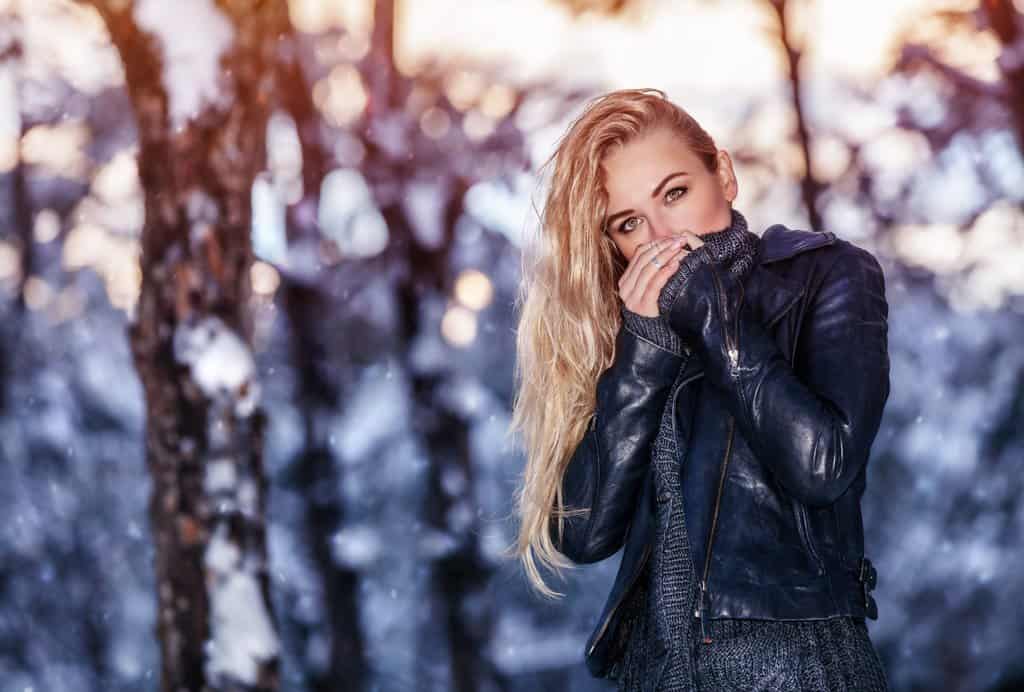As great leather jackets are, some might not be suitable for winter or very cold weather. Leather jackets are naturally warm pieces of clothing as they are made of thicker and sturdier material than fabric, but a leather jacket for winter may need some other features. Learn everything you need to know about how to determine whether a leather jacket is suitable for winter or not, what to choose, and how to protect your leather jacket during winter.
Are leather jackets warm?
Warm is a subjective feeling, but will it help fend off the cold? Yes. Whether that increase in temperature is enough for winter is another story, however. There are leather jackets that are made with thinner linings to be used in warmer climates or more neutral climates, these may not be suitable for winter temperatures and will require extra layers.
Can you wear leather jackets in winter?
Yes absolutely. There is nothing stopping you from wearing leather jackets in winter. However, if you are planning to let this be your only protection against the elements, then it may not be enough, depending on the type of leather jacket you’re wearing. It is best to buy leather jackets designed for cold weather with thicker lining.

What leather jackets to wear during winter
If you don’t plan to layer up and make your leather jacket the outermost layer of clothing, then it is best to buy the right type of leather jacket for the climate. When it comes to warmth, the lining plays a bigger role than the leather on the very outside of your jacket. Here’s a list of what a winter-suitable leather jacket should have.
Thick Lining
The lining plays a very important role in determining whether the jacket is warm enough or not. Most jackets just have a thin layer of fabric most likely made of cotton or polyester. This will definitely not be enough for sub-50°F weather.
What you should look for are jackets with thick linings made from either synthetic or natural material. It can be made of wool, faux fur or polyester fur, fleece, or cotton. What matters is that you’re creating insulation where you can trap your body temperature and keep it within your jacket to keep you warm.
Quilted lining
Quilting isn’t just a design choice, it was made on purpose to keep the wearer warm. Quilted leather jackets are a great way to make the leather jacket warmer without wearing extra layers underneath. That being said, depending on how thick the quilting is, it may not be sufficient, and especially in very cold climates, it won’t be enough to save you from the cold. However, quilted insulation traps your body heat, and every bit of it helps.
Hoods
Hoods are a great way to add extra warmth around your head and neck. Especially fur-lined, and fur-edged hoods that have been quite common for some time on winter coats, are great for especially cold temperatures or if you’re not very accustomed to it.
Interior vest
Some leather jackets designed for winter have a removable interior vest that you can put on or take off as you please depending on how cold it is. This adds versatility and may even allow you to wear it on normal days yet have the capability to put the vest underneath when it gets cold again.
Dark color
This may not necessarily be a feature, but just a design choice. However, it is very well known that darker colors are able to absorb heat much better, and lighter colors reflect heat, making them colder. Black is your best option, but dark navy blue, dark brown, and any colors that are as dark as you can get them are better than bright colored ones.
How to protect your leather jacket during winter
Winter and cold, wet weather can have the potential to ruin your jacket if you do not protect it well. Faux leather jackets will most likely be fine as long as they are not the porous type that can absorb water. However, pure and real leather items that are breathable and can absorb water are at risk of being damaged.
In order to protect your jacket, it is best to use a waterproofing product in order to protect the leather from water damage. We recommend using beeswax or a synthetic waterproofing spray. If you want a deeper guide on this, we recommend you check out our guide about leather jackets in the rain and how to protect it.
Is faux leather warm?
Faux leather jackets are usually quite thin, however, there are many faux leather jackets designed as winter jackets. Synthetic leather by itself isn’t thick, which makes it terrible for cold winters. However, when it is designed for winter weather, a quality faux leather jacket can come with many anti-cold features. It can come with great insulating layers that can protect the user from the cold much better than regular leather jackets.
Additionally, synthetic leather that is not purposely pored, is more waterproof than real leather jackets. When real leather absorbs a lot of moisture, it can tend to get quite cold, like wearing a wet shirt.
Leather jackets in the snow
Snow isn’t as much of a threat to leather as compared to rain. However, when it is heavily snowing and your jacket is exposed to a lot of snow, it can lead to water stains, especially on suede jackets. We highly suggest the above-mentioned waterproofing methods in order to protect your jacket from excess moisture.
Waterproofing your jacket doesn’t only help prevent the jacket from getting damaged, but it also helps from protecting you from the cold as well. When leather absorbs water from the snow, it can get quite cold as mentioned previously.
Best climates to wear a leather jacket
Wearing a leather jacket isn’t really limited to a certain climate. Leather garments can be used even when it’s not winter or snowing, so it’s up to you if you want to wear them on sunny, rainy, or cold days. However, since leather jackets are mostly thick material, we recommend that you wear them only during the fall or spring for reasons mentioned in the section before.
When the temperature drops down to 50°F or lower, a thicker leather jacket is ideal. You can find these in leather garments with inner linings made from cotton, shearling, or wool lining. During cold nights when the temperature is around 60°F, a thinner leather jacket is sufficient to make you feel cozy.
Layering your leather jacket
If you feel like your leather jacket is not warm enough for winter and snowy days, there’s no need to buy a new and thicker one. You can always learn how to layer your clothes and make your leather item more versatile.
Here are some of the clothes that you can use with or underneath your leather jacket for layering:
Turtlenecks
This staple piece can be used as a subtle layering with your leather jacket. Turtlenecks are not going out of style soon plus they always look great paired with a leather jacket. Just make sure that when it’s extra chilly outside, you should go for the knitted and chunky ones to keep you warmer.
Knitted Scarves
A knitted scarf, or scarves in general, is a staple in countries that experience winter or extremely cold climates. It’s very easy to wear and it can go with almost any type of clothes, especially a leather jacket. You can also go for different patterns and textures to add dimension to your leather outfit.
Warm Hoodie
If your leather jacket doesn’t come with a hood attached to it, you can use a warm hoodie underneath instead. If your leather jacket is on the tighter side, you should wear a thinner hoodie so you won’t feel uncomfortable when moving around. This comes at the cost of being colder, however.
Conclusion
Whether you’re looking to buy a leather jacket for winter or wondering whether you are able to use your existing leather jacket for the upcoming cold season, there are always ways for you to rock a leather jacket in any weather condition. Whether it’s layering or getting yourself a fur-lined or quilted winter coat, this guide aims to make you confident in wearing your leather jacket no matter what the outside conditions may be.
We hope we have helped you learn more about wearing a leather jacket in winter and what you can do to be able to wear one.
FAQ
How cold is too cold for a leather jacket?
If the temperature is down to the freezing point, we don’t recommend wearing a leather jacket because the fibers can get stiff. Leather has moisture content and really cold weather can potentially freeze the fibers and seize the jacket making it more difficult to move.
What are the advantages and disadvantages of wearing a leather jacket during winter?
Wearing a leather jacket during winter can help warm you up, especially if you have learned the technique of layering clothes. It’s also great when it comes to deflecting cold, harsh winds since the leather material is more solid compared to fabric.
On the other hand, leather garments can absorb a lot of moisture which can lead to you feeling colder. Exposing your leather jacket too much in wet conditions can also lead to water damage. We highly suggest you use beeswax or any waterproofing sprays to protect your leather jacket from excess exposure to moisture.



